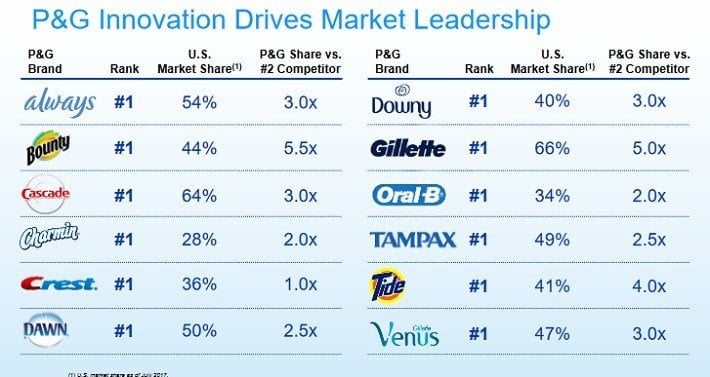Procter & Gamble (PG) stock has lost 16% since it peaked, six months ago. The stock has dramatically under-performed S&P in almost any time frame one can check out. To be sure, it has under-performed the market index during the last 5 years (2% vs. 79%!), 2 years (-5% vs. 36%) and the last 12 months (-14% vs. 15%).
And yet, P&G has one of the longest streaks of dividend growth in the entire stock market. It is a Dividend King, a group of just 25 stocks that have increased their payouts for at least 50 consecutive years. You can see the full list of all 25 Dividend Kings here.
ValueWalk readers can click here to instantly access an exclusive $100 discount on Sure Dividend’s premium online course Invest Like The Best, which contains a case-study-based investigation of how 6 of the world’s best investors beat the market over time.
Click here to download my Dividend Kings Excel Spreadsheet now. Keep reading this article to learn more.
This article will discuss the company’s fundamentals, and why the stock may be interesting for dividend growth investors.
Business Overview
Procter & gamble is a consumer stalwart that is 180 years old and sells its products in more than 180 countries. It generates 55% of its sales outside North America, with 35% of its sales in emerging regions.
Source: Barclays Global Consumer Conference, page 8
The performance record of the company for almost two centuries is certainly admirable. Nevertheless, during the last decade, the consumer stalwart has faced some strong headwinds, which have challenged its growth trajectory.
The greatest headwind is the continuously heating competition in the retail sector. As consumers are becoming increasingly price-conscious, private-label products are gaining popularity and are thus gaining market share while also exerting downward pressure on the prices of their competitors.
In addition, large retailers, such as Walmart (WMT) and Target (TGT), are on a price war and hence they exert great pressure on their suppliers for lower prices. Consequently, Procter & Gamble has seen its gross and operating margins remain essentially flat during the last decade, around 50% and 20%, respectively. Moreover, the company has failed to grow its revenues for six consecutive years.
Part of the decrease in the revenues can be attributed to the unprecedented sale of brands in the last few years but even the core revenues have not grown for six years. Furthermore, the company has essentially failed to grow its earnings-per-share for a whole decade.
Growth Prospects
While the above headwinds help explain the stagnation of Procter & Gamble, the company also has another problem, namely its own size. As it has a market cap of approximately $200 billion, and has already expanded in almost every country on the planet, it is only natural that it finds it increasingly hard to grow.
On the bright side, the consumer stalwart is in the process of reinventing itself. More precisely, it is doing its best to make the product packaging as appealing as possible while it is also trying to enhance the effectiveness of its advertisements. Moreover, the company has sold an unprecedented number of low-margin, low-growth brands in recent years and has thus reduced their number by almost two-thirds, from 170 to 65 brands.
In this way, the management will now be able to focus on the most promising brands, which have the highest growth potential. Organic sales were positive over the course of 2017.
Source: Barclays Global Consumer Conference, page 5
As the result of the first half of this fiscal year show, the company is on track to deliver core earnings-per-share growth of up to 7% this year. Therefore, after years of stagnation, the transformation seems to be bearing fruit.
While Procter & Gamble is present in almost every country, it still has room to grow in some emerging regions if it improves its execution. Thanks to its ongoing transformation, the company has already shown some encouraging signs.
For instance, in China, Japan and Mexico, it has grown its adjusted sales by 7%, 8% and 9%, respectively, in the first half of this fiscal year. China and India are very promising markets, as they have population of more than one billion each and their middle classes keep growing at impressive rates. Therefore, the consumer stalwart has ample room to grow before it reaches its saturation point.
It is also important to note that Procter & Gamble was negatively affected by a strong dollar until a year ago. However, although the Fed continues to raise interest rates, the dollar seems to have posted a solid top and has been weakening during the last year. Whenever the Fed raises interest rates, the dollar does not rally, as the market has already priced in very aggressive hikes.
On the other hand, whenever the US economy shows any sign of weakness, the dollar tumbles. All in all, the dollar has already lost about 20% in a year and is likely to remain weak for the foreseeable future. This will be a strong tailwind for Procter & Gamble, as it generates 55% of its sales abroad.
Competitive Advantages & Recession Performance
The most important competitive advantage of Procter & Gamble is the strength of its brands. As the company is focused on producing the most innovative and highest-quality products, its brands are viewed by consumers as premium.
When consumers purchase products of this stalwart, they know that they pay a premium over the other brands but they also rest assured that they are not going to face any problems with the quality or functionality of the products. As a result, the company is the market leader in the 10 categories it operates in.
Fortunately for its shareholders, the company does not rest on its laurels. To be sure, it has spent about $1.9 billion each year on R&D in each of the last six years in order to develop technologies and obtain patents. In this way, it easily maintains its status as the market leader.
Moreover, it has spent more than $7 B per year on advertising in the last six years in order to continuously remind consumers that its products are unique and thus deserve their premium status. As most of its competitors cannot spend such excessive amounts on R&D and advertising, the ability to spend such enormous amounts certainly creates a significant moat over its competitors.
In addition, as its products are essential to consumers, the company has always exhibited great performance during recessions.
P&G’s competitive advantages allow the company to remain profitable, even during periods of recession. Earnings held up very well during the Great Recession:
- 2007 earnings-per-share of $3.04
- 2008 earnings-per-share of $3.64 (20% increase)
- 2009 earnings-per-share of $3.58 (1.6% decline)
- 2010 earnings-per-share of $3.53 (1.4% decline)
P&G enjoyed strong earnings-per-share growth in 2008, and experienced only a mild dip over the next two years. While most investors have forgotten how fierce a recession and a bear market can be, they should not underestimate this characteristic of Procter & Gamble.
Valuation & Expected Returns
P&G expects core earnings-per-share growth outlook of 5% to 7% for fiscal 2018, from fiscal 2017 earnings-per-share of $3.92. Assuming 6% growth, earnings-per-share are likely to reach approximately $4.15. Based on this, the stock has a price-to-earnings ratio of 19.0.
Source: Value Line
Moreover, the chart shows that it has been almost four years since the last time the stock was trading at such a low price-to-earnings ratio. Therefore, investors who have faith in the management and believe that the ongoing transformation will bear fruit should consider purchasing the stock at its current level.
Procter & Gamble is a Dividend King, that has raised its dividend for 61 consecutive years and has paid a dividend for 127 consecutive years. This degree of consistency is certainly a testament to the strength of its brands and their resilience even amid the roughest economic conditions.
Unfortunately, the company has drastically reduced its dividend growth rate in the last few years. While it used to raise it by almost 10% per year until 2014, it has raised it by 3%, 1% and 3%, respectively, in the last three years.
Dividend growth is likely to continue to be limited for the foreseeable future. On the other hand, it is the first time in more than two years that investors can purchase the stock at a 3.5% dividend yield.
Therefore, as the company will continue to raise its dividend for years, those who purchase the stock now lock in a 3.5% dividend yield and are positioned to see it grow for years. In fact, the company is expected to announce its next dividend hike next month.
Even if Procter & Gamble’s valuation remains steady, the stock can generate positive returns from earnings growth and dividends. A reasonable breakdown of total returns is as follows:
- 5% to 7% earnings growth
- 3.5% dividend yield
Based on this, the stock would return 8.5% to 10.5% annually moving forward. This would be a satisfactory rate of return for a high-quality blue chip like Procter & Gamble.
Final Thoughts
Procter & Gamble has dramatically under-performed S&P for years. However, the company is going through a major transformation right now. In addition, it is the first time in more than two years that investors can purchase the stock at a 3.5% dividend yield. Moreover, the stock is trading at an almost 4-year low P/E ratio. Therefore, those who believe in the restructuring plan of the company should consider purchasing the stock.
Thanks for reading this article. Please send any feedback, corrections, or questions to [email protected].
Article by Sure Dividend
ValueWalk readers can click here to instantly access an exclusive $100 discount on Sure Dividend’s premium online course Invest Like The Best, which contains a case-study-based investigation of how 6 of the world’s best investors beat the market over time.








